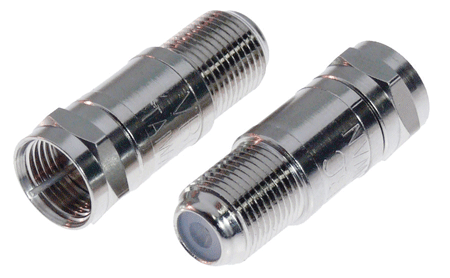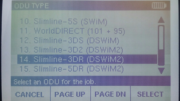One of the guys in the office asked me the other day about whether or not to use DC blocks in the satellite installation they were planning. So, I thought that I would do a little article about these parts, when you would use them, and why they are important. First, the easy answer:
Easy answer: It’s the opposite of a power passing splitter.
We told you all about power passing splitters in an earlier article. Power passing splitters make sure that your equipment gets the power it needs. DC blocks, also called voltage blocking couplers, make sure that your equipment doesn’t get cooked.
Most devices aren’t designed to take DC power in from their coaxial lines. In fact, if you put a powered connection into an input that isn’t designed to take it, you’ll probably fry that device. (It’s happened to people I know.) When you use something like the DIRECTV SWM system, the ports that carry voltage are very well labeled with red centers, and the splitters used in that system are designed not to let DC power get to those other ports. That’s a good thing.
What if you’re putting together something custom?
You might not be able to rely on a splitter to block that DC voltage, and the equipment you’re using might be too expensive to risk. If that sounds like you, you’ll like the cheap insurance offered by voltage blocking couplers. These friendly little devices don’t cost a lot and they’ll block DC power coming into your devices. They don’t contribute to any measurable signal loss, either.
What happens if you use a DC block in the wrong place?
You may ask yourself, why aren’t there DC blocks on every splitter and every device? It’s a very inexpensive bit of insurance. Well, there are times you actually do want current on the coaxial line. Satellite equipment, antenna amplifiers, and several other devices rely on current that comes up the line. The current on the line doesn’t interfere with the signal. The current travels through the center of the wire while the signal sits on the outer skin of the wire. There are some fancy physics reasons for this that really don’t matter right now.
It’s important to identify which equipment does need current and make sure you’re providing it. Otherwise, that equipment just won’t work.
What happens if you don’t need a DC block and you need one?
The good news here is that a lot of equipment does have voltage blocking built in. It’s built into most satellite splitters, for example. However, if you are putting current where it shouldn’t go, you risk destroying the equipment connected to the cable. It may not happen immediately, but eventually the excess current will burn something out inside and that thing will become useless.
Of course, not every installation will need these couplers. However, if you’re working with power inserters in ways that the manufacturer didn’t count on, you’ll be glad you had a couple of these in your toolbox.
Get voltage blocking couplers and a whole lot more from Solid Signal
SolidSignal.com has tens of thousands of hard-to-find installation accessories. Shop our great selection! If you’re not sure what you need, call us! We’re here during East Coast business hours at 888-233-7563. If it’s after hours, just fill out the form below. We’ll get back to you, usually within one business day.





